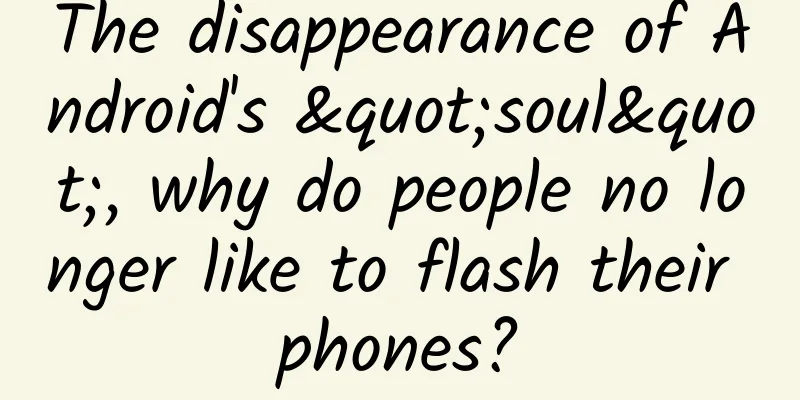The disappearance of Android's "soul", why do people no longer like to flash their phones?

|
"Flashing" may not be unfamiliar to the majority of digital enthusiasts. It is not only a kind of exploration of digital, but also the love and interest of countless Android users. We know that the biggest difference between Android and iOS is openness. Although iOS is better than Android in terms of fluency, thanks to the openness of Android, third-party Android ROMs emerge in an endless stream and are loved by more people. Take Xiaomi's "Born for Enthusiasts" and OnePlus' "Little Prince of Flashing" for example. They both grew rapidly based on the model of unlimited flashing. However, the flashing culture has gradually disappeared in recent years. Why is this? First, the difficulty of third-party ROM development has increased. In recent years, Google has gradually tightened the source code of Android, dividing Android into the open source project AOSP and the closed source project GMS, and extracting more and more functions from AOSP and adding them to the closed source GMS. Therefore, there is a restriction on Huawei phones pre-installing GMS to suppress Huawei. Therefore, when developing code, third-party ROMs have to take on more functions, which undoubtedly increases the difficulty of development. Secondly, mobile phone manufacturers are increasingly restricting flashing to ensure after-sales service and brand image. For example, some manufacturers directly lock the bootloader from a technical perspective, preventing users from making changes to partitions such as Recovery and System, or even if there are no technical restrictions, they will cancel the quality assurance after flashing the phone. This requires those who want to flash their phones to carefully consider the risks and consequences of this operation. Third, the mobile phone OS is getting better and better. It is not only fully functional, but also stable and does not crash. At the same time, the original ROM also has some unique localized services. For example, Huawei mobile phones can enjoy a lot of high-quality but copyright-restricted music online. If flashing affects some functions, it will be more trouble than gain. This goes against the original intention of flashing. If you can't experience better results, why spend extra money on it? Fourth, people are becoming more and more dependent on their phones. They not only store work materials, especially for designers, who may store a lot of customer drawings and related contact information, but also many details of life are recorded by the phone, which is of commemorative significance to everyone. Once the phone is flashed, data transfer or loss will be faced, which is quite troublesome, so users are used to "being faithful to one phone". It is simpler and more convenient to directly transfer data after two years to a new phone with better performance. Therefore, now no one likes flashing the phone anymore. The past glory is ultimately a passing moment in the process of technological development. The era of flashing the phone, which was once enjoyed by everyone, is gone forever. What do you think of this "flashing the phone" culture? |
Recommend
27 quick money-making projects for lazy people
Real-life cases + practical techniques will teach...
Datou Laoha·Starting from 0-1 in the same city, how to make a short video popular
Datou Laoha’s local account started from 0-1, how...
Introduction to Huawei App Market paid promotion process and resource positions!
Introduction to Huawei AppGallery Paid Promotion ...
DingTalk is aggressively grabbing the TO B digital office market. Are Enterprise WeChat, Kingdee, Graphite Docs, Maimai and others in danger?
On the evening of December 9, DingTalk held a gra...
How to make Tik Tok? 6 operation and promotion techniques of Tik Tok!
There are two main points to focus on when doing ...
I am promoting on Baidu, but why is my budget being consumed so quickly and I still don’t get many calls?
Many bidding promotion personnel who have just en...
Musk's chopsticks "grip" the rocket: a space version of a claw machine
You know about claw machines, right? You put in c...
SOUL product operation analysis
Soul is an APP focusing on stranger social networ...
Jordan Introduction: How should SEO website structure be optimized?
There are many ways to optimize the website struc...
From 0 to 20 million, the 3-year growth path of Get APP
1. Get the PMF of the app PMF, or product-market ...
3000 words to understand Weibo operation and promotion routines!
Why do I operate Weibo? Because browsing Weibo is...
The luxurious "birthing room" for fish on the seabed is 150 times the size of Beijing
Recently, scientists' research objects seem t...
Brand marketing strategy analysis case!
Under the influence of the health trend, the plan...
Uncle Wolf’s virtual online course project earns over 10,000 yuan a month. Here is a video tutorial of the virtual online course project operated by Uncle Wolf himself!
Let me briefly explain to you the essence and log...









